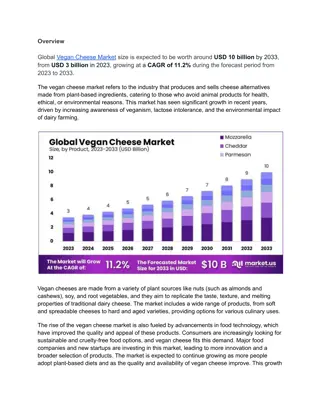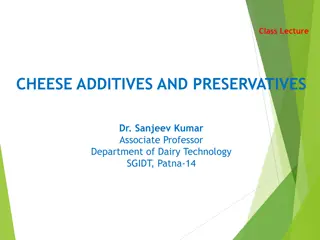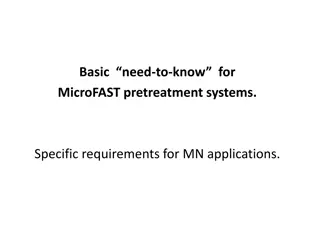
Pretreatments for Cheese Making: Overview of Milk Treatment Steps
Learn about the pretreatments involved in cheese making, including pasteurization, chilling, cold storage, clarification, and bactofugation. These processes are essential for ensuring the quality and safety of cheese production. Discover how each step impacts the final product and the measures to overcome any potential issues during milk treatment.
Download Presentation

Please find below an Image/Link to download the presentation.
The content on the website is provided AS IS for your information and personal use only. It may not be sold, licensed, or shared on other websites without obtaining consent from the author. If you encounter any issues during the download, it is possible that the publisher has removed the file from their server.
You are allowed to download the files provided on this website for personal or commercial use, subject to the condition that they are used lawfully. All files are the property of their respective owners.
The content on the website is provided AS IS for your information and personal use only. It may not be sold, licensed, or shared on other websites without obtaining consent from the author.
E N D
Presentation Transcript
Class Lecture PRETREATMENTS For CHEESE MAKING Dr. Sanjeev Kumar Associate Professor Department of Dairy Technology SGIDT, Patna-14
INTRODUCTION Most cheese making today involves the treatment of milk by one or more processing steps prior to addition of coagulation and starter culture The simplest and earliest technological intervention, driven by safety concerns,--the pasteurization of milk Pasteurization inactivates some enzymes, reverse shifts in the mineral balance of milk and influences the microflora of non-starter lactic acid bacteria (NSLAB) in the final cheese
CHILLING AND COLD STORAGE Raw milk is sometimes cooled to about 4 degree C and stored in refrigerated tanks or storage tanks prior to its conversion into cheese Practice of storing milk at refrigerated temp. not only increases the possibility of growth of psychrotrophs but also alters the physico-chemical properties of milk components like casein and minerals. l Due to these alternations ,many properties change significantly like rennet coagulation time increases, firmness decreases and moisture retention increases.
lThe impaired technological properties as a result of chilling and cold storage of the raw milk - improved by adopting measures Acidification of cheese milk with lactic acid to pH 6.5. Addition of calcium chloride @0.02%. Addition of more rennet within permissible limits. Use of higher renneting temperature. Use of higher cooking temperatures.
CLARIFICATION Clarification ----- centrifugal process used in dairy industries Used ------ remove leukocytes, cellular debris and particles from earth or fodder gaining entry into milk. Centrifugation of milk by the clarifier removes much of small sized particles in milk, having a specific gravity higher than 1.032, particularly dirt, cells and larger microorganisms if they are present in clumps.
BACTOFUGATION Bactofugation --- physical process through which bacteria are removed from milk, the size and density of bacteria being the criteria for their removal The other factors deciding the efficiency of Bactofuge to remove bacteria --- Initial bacterial load, Pre-treatment of milk, Throughout of machine, Volume of bactofugate to throughout, Frequency of partial desludging and duration of the run. lBactofuge is a clarifier with one inlet for raw milk and one outlet for treated milk.
lConsists 2-4 nozzles fitted into the bowl wall for the discharge of skim milk. lBacteria are subjected to a centrifugal force of the order of 7000-9000 gravitational force. lThe bactofuge system ----used in the cheese industry where its high-cleaning capabilities ----- used to remove spores from cheese milk that could cause late fermentation in semi-hard cheeses.
Effect of Bactofugation on cheese making Effective method for preventing late blowing defect in semi-hard or hard varieties of cheeses. It is mainly due to removal of anaerobic microorganism (clostridium tyrobutyricum) Facilities reduction or elimination in the use of nitrates (nitrates are added to prevent late fermentation in cheese) Weakens the coagulum during cheese making which can be overcome by addition of calcium chloride.
HEAT TREATMENTS Milk for cheese manufacture ---- heated to To eliminate pathogenic bacteria, To minimize damage to casein by proteolytic bacteria on storage To incorporate heat-denatured whey protein in curd, ------- improving cheese yield. lFurthermore, more severe heat treatment of milk ---- applied to inactivate spores from Clostridium tyrobutyricum
EFFECT OF HEAT TREATMENTS Heat-treatment of milk at condition severe than those used for conventional pasteurization results in Denaturation of whey proteins, Interaction between whey proteins and casein micelles and Transfer of soluble calcium, magnesium and phosphate to the insoluble colloidal state Casein micelles are very stable at high temperatures, although changes in zeta potential, size, hydration of micelles and some association -dissociation reactions do occur under severe heat treatment .
Denaturation of whey proteins exposes side chain groups originally buried in the native structure, particularly reactive thiol groups, and the unfoIded self-aggregate or interact with casein micelles, through interactions with k-casein The extent of association of denatured whey protein with casein micelles ----- dependent on The pH of the milk prior to heating, Levels of soluble calcium and phosphate, Milk solids concentration and Mode of heating (direct or indirect).
High heat treatment of milk prolongs rennet coagulation times and Reduces the strength of rennet gels leading to impaired syneresis The adverse effects on coagulation --- attributed to the inhibition of hydrolysis of k-casein by chymosin due to the beta-lactoglobulin/k-casein complex at the micelles surface impairing the accessibility of k-casein, to reduced reactivity of renneted micelles with attached denatured whey proteins to aggregation, or To a reduction in the concentration of micellar calcium.
HOMOGENIZATION FOR CHEESE MILK Primary aim of homogenization of milk -- to reduce the size of the fat globules, thereby delaying their creaming rate In raw milk, fat globule size commonly range from 0.2-15 micrometer, and homogenization generally aims --- reduce the maximum to < 2micrometer For this purpose, two-stage valve homogenizers - used, -- operate at pressure of 20MPa Recently, novel homogenization devices, e.g high- pressure devices and microfluidisers, ---- operate at pressure of several hundred MPa and achieve greater reductions in fat globules size
In cheese making, homogenization of cheese milk --- Preventing creaming of fat globules, Reducing fat losses in the whey or Controlling development of free fat in the cheese Due to the reduction in the fat globule size on homogenization, The total surface area of fat globules increases and the amount original fat globule membrane material is by far insufficient to fully cover the newly-formed surface. As a result, other surface-active components of milk, primarily caseins and, a lesser extent, whey proteins, become absorbed onto the surface of the newly formed globules
The absorption of caseins onto the fat globules ----following implication for cheese making characteristics of milk Casein surface area in milk - increased, but the amount of micellar casein -- reduced. Two types of particles with a casein micelle surface layer exist: native casein micelles and casein-covered fat globules. When absorbed, casein micelles tend to spread over the surface of the fat globules and hence increase in effective surface area but with reduced surface density of k-casein.
u The rennet coagulation time (RCT) of unhomogenised milk---- generally lower than that of homogenized milk u Probably related to the larger casein surface area in homogenized milk, as well as the lower surface density of k-casein u u Cheese curd from homogenized milk shows poor syneresis and, as a result, has high moisture content. Furthermore, cheese curd prepared from homogenized milk --- also often characterized by a coarse and brittle structure.






















